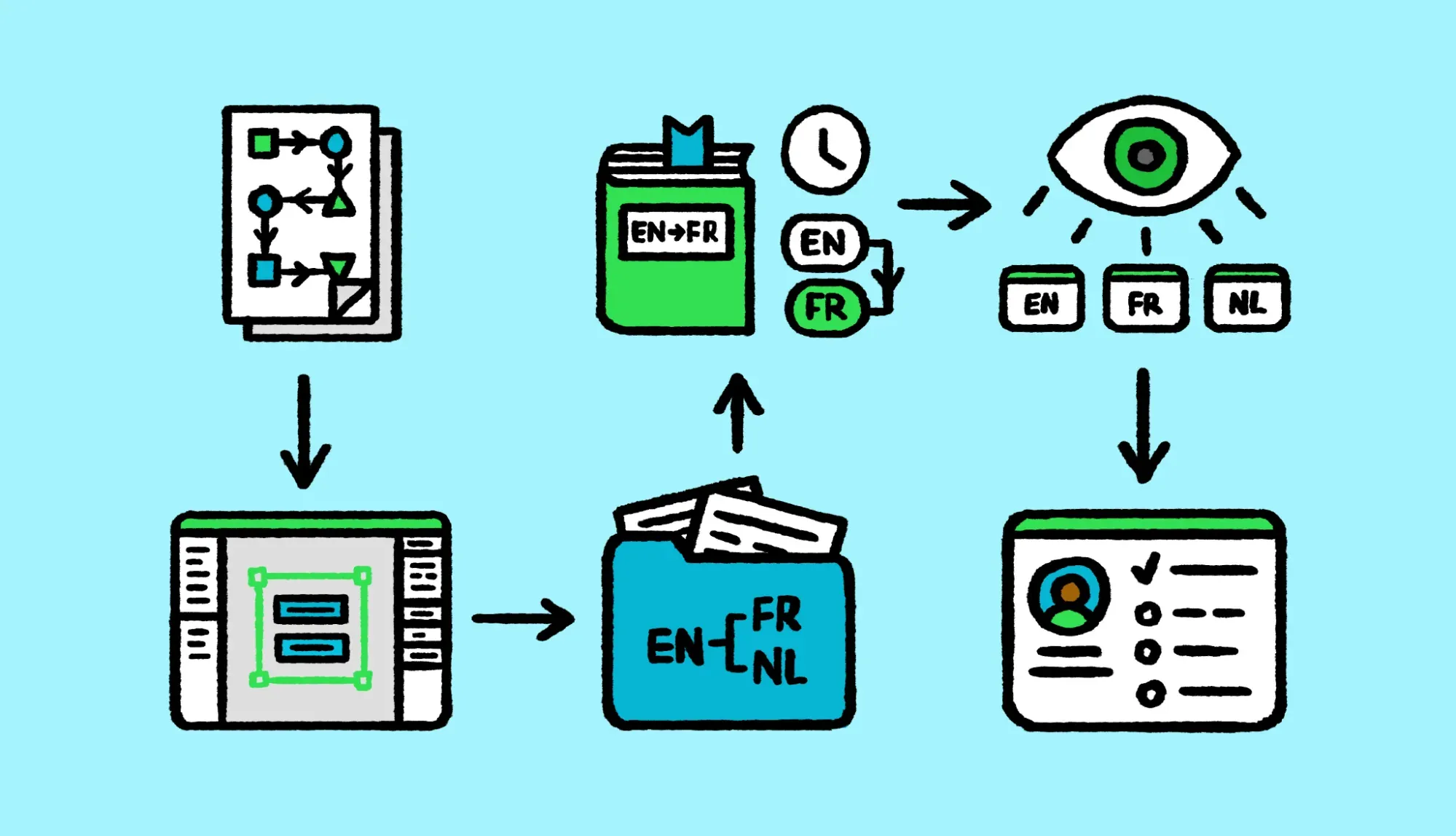Despite being a crucial touchpoint with customers that's been around for nearly 30 years, email is often overlooked when it comes to a company's localization efforts. If you've translated your website and app but neglected to localize your email communications, you may be missing out on a significant opportunity to connect with your international audience.
In this article, you’ll see some tips and tricks for localizing content on this most personal of channels – complete with examples.
The benefits of email localization
Look around your business, and you’ll see emails to customers fall into a few distinct groups. There are your service emails, automatic responses to customer actions like changing a password or making an order. There are marketing emails, introducing products and services and offering incentives to purchase. Announcement emails, informing people there’s a new blog or download at your site. And so on.
What they have in common: you want all of them to drive some sort of customer action – whether that’s to buy a product, update their information, or simply read what you wrote. The main benefit of email localization is that it makes these outcomes more likely. Here’s why.
Increase open rates
First, a subject line in someone’s native language helps you clear the first hurdle: getting the email opened. Any non-native speaker of English sees a daily Inbox crammed with messages that aren’t in her mother tongue; communicating in a customer’s preferred language makes you look more caring, more aware of their needs, more concerned about their comfort. Making your recipient more likely to read on.
Increase clickthrough rates
It’s no different for calls-to-action like clicking a link. Whether you embed a link in a piece of text or include the full URL in the body of the email, effective localization increases the chance of your reader following through, improving the click-through rate. Simply because it’s taken them less effort to understand your email, and they feel more positive about seeing more.
(A note: many successful companies localize the URL address as well as the link text, naming the actual pages in the local language. Why? Because a French speaker doesn’t want to go to yourwebsite.com/contact-us; he wants to see yourwebsite.com/contactez-nous or similar. Every little bit of trust-building helps.)
Ensure higher readership
The common thread here: unless you’re completely multilingual, reading in your own language takes less effort. It’s just easier and more enjoyable, which means your localized email text has a head start. You’re demonstrating an awareness of the local market, showing respect and understanding.
Smooth the user experience
It’s jarring if clicking a link takes you to a page in another language, even if you’re fluent in both. True localized communication goes end-to-end, from the first web link to the most detailed customer service response. If you start in their language, make sure you finish in the same language – it makes every customer journey look seamless.
Reduce customer service costs
In many world regions, English as a second language differs significantly from “standard” British or American. (The various dialects of English in Southeast Asia are wonderfully diverse, but they’re some way from the Queen’s English!) So offering customer service and support in the local language – whether that’s Tagalog, Bahasa, or Hindi – can solve problems faster and reduce recurrences, since it’s easier for local customers to understand and share your instructions.
There are many more – and it’s about a lot more than just translation. Let’s deal with that next.
The difference between email translation and localization
Translate the bouncy, upbeat jocularity of an American marketer’s email into (say) Chinese, and you’ll have some problems. Because regional humor and culture don’t travel well. (Think of the double meaning of “Netflix and chill”.) You’ll also risk falling foul of local regulations; making a direct comparison with a competitor’s product, for example, is illegal in some countries. This highlights how translation and localization require a nuanced understanding of local contexts. That’s why localization is a different task to translation. Getting your message across clearly and legally is about more than the words.
That’s why at Lokalise we often use a new term: transcreation. A skilled translator is a student of human culture; he or she knows the character traits and behavioral nuances of a target market as well as its language. And that person will “recreate” your intended message in a way that’s right – not simply translating word-for-word.
The email localization process
Like any business task, email localization needs a plan – so here’s a basic strategy for approaching it.
Researching and understanding the target audience
The first task is fundamental, but it’s also fun: assessing your target market and finding out what makes them tick. You can carry out a big, pricey survey if you like – but the best insights often come from a simpler approach: asking experts in that market to write you a customer persona.
A customer persona is a snapshot of your ideal customer, complete with his/her aspirations and ambitions. It has depth and color. It goes into detail about that person’s hobbies and interests, what motivates them to succeed, why they do the job they do.
A persona (you may need more than one) can provide real insights into what makes populations different. Why Americans drive pickups and Asians don’t; how eating and drinking patterns differ across borders; why some cultures are family-oriented and others aren’t. This research shows you what your new targets will and won’t like about your current email texts – giving you a place to start.
Adapting content to local preferences
The content of an email is more than words. You’ll see headers, logos, images, even video. And the way people consume content – called “reading gravity” – differs from culture to culture. Some focus on words first; others are drawn to images. And some colors are a no-no. This extends to your photography and branding; a scene of blocky Brutalist architecture creates unpleasant associations for those who grew up behind the Iron Curtain.
So when you look at your current emails for localization, look at them as the whole fruit – seeing logos, fonts, even column widths as candidates for localizing. Your CTRs and conversions manager will thank you. Check out our figma plugin that makes the design led localization process easy.
Translating (and transcreating!) content accurately
Of course, the biggest job is translating words and phrases – and it’s the part that usually takes the longest. So first up, prefer translators with experience of living in your target locale and who understand its tics and quirks.
If this sounds like giving them too much freedom and losing control, remember your goal is not to translate each email accurately – it’s to ensure each email is most effective for its role. So if that means hitting your 5% CTR target requires a complete culturally-aware rewrite, that’s what you should do.
Formatting and design considerations
Next, some housekeeping: make sure your transcreated text and assets flow properly when localized. Different languages take up different space on the page; some are written right-to-left, the opposite of English; others are read top-to-bottom, while a font size normal in Arabic (for example) looks very small to European eyes! What’s more, the same email subject line can take up a very different character count when translated – and it may breach limits for best-case SEO. So as part of your plan, be conscious of how your design choices look to a local reader.
Testing and Optimization
Once again: localization is an ongoing process, not an event. Successful email localization is a constant wash-rinse-repeat of looking at Opens, CTRs, conversions, unsubscribes , email testing results and more, and seeing opportunities for improvement. Look at A/B splitting your emails, changing one thing. Does simply using red design elements instead of blue raise CTRs in Asia? Look at the data, change elements, and retest – always keeping an open mind.
Email localization: some best practices
All this might sound like a massive task – so let’s look now at some quick wins with a disproportionate impact on localization effectiveness. Put these in place first:
- Use a compelling subject line. From your personas, what’s the one thing you could say that each audience will find most appealing? Cost-based, or benefit-driven, or an emotional plea? It’ll differ across borders. So this is a great place to start.
- Use appropriate greetings and sign-offs. Another quick win. Respectful forms of address to groups of people (called “register”) tend to be standard in countries where it matters, such as Japan and Korea. Once you’ve got the standard set it becomes an asset you can reuse in every email.
- Use dates and times in the right format. Nothing shouts “foreigner!” louder than seeing MM/DD/YYYY in places where DD/MM/YYYY is the norm, and your CRM system may need some persuading to get this right. But it’s worth doing.
- Leverage local holidays and cultural references. Christmas isn’t universal; Japan has not one but two Valentine’s Days a month apart. See what celebrations matter to your local audience and time offers to match them. Be careful though – countless British consumers get St Patrick’s Day offers each year, but the Irish holiday isn’t the big party it is in New York.
All this attention to detail gets a lot easier with the right tools – which is why Lokalise provides a complete platform for bringing it all together and connecting all the parts!
- Translation Management Systems. Effective translation looks at what needs to be done, what’s been done before, and what can be reused to save time and money. Make sure you manage your email localization with a capable system for asset management. Learn more about Translation Management Systems and how they can help your business.
- Content Management Systems. All major CMSes, like WordPress, provide facilities for multi-language websites. But not all support “multi-cultural” capabilities like changing basic page designs across markets. The further from your own language the target is (if you’re Spanish, expanding into France is easier than going into Thailand!) the more attention you’ll need to pay to this.
- Localization Service Providers. LSPs give you what a plain-vanilla translator can’t: deep understanding of local cultural nuances. Good ones are worth their weight in gold – and you’ll find many use the Lokalise platform.
- Email Marketing Platforms. Make sure it can handle text in all the world’s languages (that means Unicode, with support for all scripts) to avoid strange characters popping up in your emails. And remember to stagger your sends across borders to manage time zones – an email sent at 9.30am on a Monday is better for a B2B marketer than one sent in the dead of night.
So what happens when you get it all right? Let’s see some proof.
Examples of successful email localization
Coachhub
Coachhub acts as a platform for people development. Its users create scalable, personalized coaching programs in 90 countries – and email communication, of course, is a big channel for them.
When you receive a Coachhub email, you’ll see it in your local language, with culturally-familiar references and examples. Coachhub achieved this level of localization by integrating its workflows with Lokalise, connecting different people and resources to streamline and speed up translation processes.
Meister
Transatlantic SaaS provider Meister develops apps – and they’re very, very good at it, with their largest (MindMeister) used by 14m people. Service and marketing emails are vital for staying contact with such a large user base – so the company used email integrations with Lokalise to manage them.
Working across 10 languages, the team at Meister can localize emails more efficiently by sharing screenshots and comments inside Lokalise, while notifications keep them in touch with their translators around the world.
Specialized
Specialized is a global cycling brand, active since 1974. With so many countries on its customer list, it was using a wide variety of tools for translation and localization – making management difficult. By “specializing” on the Lokalise platform the company reduced the resource-hogging stress of localization – and now sends out emails in multiple languages around the world, each one tuned to its local market to achieve the result wanted.
Over time, Specialized has become more and more adept with using APIs and Webhooks to manage its email localization, creating competitive advantage. So it’s not just sending out more effective emails – it’s managing them more effectively, too.
See more examples in play at our Case Studies collection!
Treat email localization as part of the whole
This article’s about localizing email. But our takeout thought is broader. Email localization should be an integrated part of your overall marketing efforts, not an isolated project. Because localization works best when you treat it as an end-to-end process for communicating with your customers, with no part of the puzzle missing.
As you’ve seen, hundreds of companies worldwide are using the Lokalise platform to do it. Can it do the same for you? Book a platform demo where we can show you all the features that can help with email localization.
FAQs
How can I ensure accurate translation of my email content?
As we state, “accurate translation” isn’t always the goal. What you want is accurate transcreation – content that creates the right positive feeling among your target customers and drives the right response. That can mean email content in a different language isn’t a direct translation of your native language.
But for both purposes, the best route to accuracy is to use expert translators, in your target market, translating into their own language. (For most translators, it’s far easier to translate to their native tongue than from it.) Make sure the goals and expectations of each translation project are completely understood – and then let them do what they’re best at!
What are some common mistakes to avoid in email localization?
The biggest mistake is treating email localization as a “word-for-word” straight translation job. This will miss all the cultural nuances and expectations that make customers comfortable, so it’ll lose you clicks, conversions, and repeat sales.
Another error is to localize emails without localizing all the content that connects to them: web pages, URLs, follow-up messages, and so on. It’s best to see email localization as one part of the whole, not an isolated project.
And third, avoid the temptation to treat each email translation as a separate project, exchanging Word documents with different translators! Managing it all on a platform – like Lokalise – lets you keep track of everything, store text and assets in a library for reuse, and communicate easily with translators using screenshots and tags. A platform makes it all easier.




